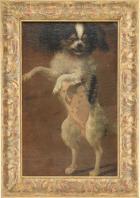The Phalène is the earliest form of the Papillon; the appearance of the erect-eared variety was not documented until the 16th century, by which time the Phalène had been portrayed in numerous paintings, particularly in portraits of the wealthy by Old Masters and their students. Belgium, France, Spain, and Italy have all been credited with the creation or development of Butterfly Dogs. The Papillon gained popularity after the turn of the nineteenth century. By the middle of the 20th century, the Papillon’s popularity had far outstripped that of the Phalène, which sank low enough into obscurity to become endangered. Fortunately, the breed had its fanciers and did not slip into extinction. At some point the variety was named phalène, or ‘night moth’. The 21st century has seen a revival of interest in the Phalène, with its fanciers pointing out that in countries where it is judged together with the Papillon, judges must be familiar enough with the breed standard to appreciate the qualities of a well-bred Phalène, and not confuse its dropped ears with those of a semi-erect eared Papillon, which would suggest a conformation fault.
Son and pupil of the Dutch still life painter Jacques de Claeuw, called "Grief". “Claeuw” in Dutch and “griffe” in French both mean “claw”.
Painter of hunting still lifes : the early ones resemble those of Jan Fyt, the later ones those of Pieter Gysels. Occasionally he also painted fruit still lifes and barn scenes.
When Adriaen was about 10 years old the family moved within the Dutch Republic to Zeeland.
Recorded in 1687 as a painter joining the Guild of Saint Luke in Ghent, Flanders.
Left Ghent soon for Antwerp, where he married a wealthy woman in 1689.
Active in Brussels in 1690.
In 1694 first active in Antwerp, then in his native Leiden, so back in the Dutch Republic.
Left again for Antwerp, was there already in 1698 and joined the Guild in 1699/1700.
A few years later he reportedly moved to Brussels, where he is thought to have spent the rest of his life.
According to Jan De Maere (1994, p. 188) Adriaen de Gryef died in 1715.
According to Adriaan van der Willigen and Fred Meijer (2003, p. 96) he must have died in or after 1722. They base this on a painting in the Musée des Beaux-Arts in Tournai which is dated 1622 : they think it could be typical of his latter-day production in Brussels although the size is exceptional and the subject somewhat unusual (a mix of dead and live birds).
Paintings by de Gryef can be found in numerous European museums.


